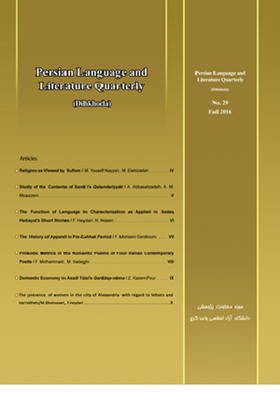-
-
List of Articles
-
Open Access Article
1 - Religion as Viewed by Sufism
Mohammad Yousef Nayyeri Maryam Elahizadeh -
Open Access Article
2 - ASJJOI
Leil jani Ali Mohamad Sajadi -
Open Access Article
3 - Study of the Contents of Sanāʾi’s Qalandariyyāt
Ali Abbas alizadeh Ali Mohammad Moazzeni -
Open Access Article
4 - The Function of Language in Characterization as Applied in Sadeq Hedayat’s Short Stories
Fateme Heydari Nasrin Naseri -
Open Access Article
5 - The History of Apparel in Pre-Zahhak Period
Fateme Mohseni Gerdkouhi -
Open Access Article
6 - Prosodic Metrics in the Romantic Poems of Four Iranian Contemporary Poets
Farhad Mohammadi Mohammad Sadeghi -
Open Access Article
7 - Domestic Economy in Asadī Tūsī’s Garšāsp-nāma
Zahra KazemiPour -
Open Access Article
8 - Women’s Presence in Eskandar-nāma as Narrated by Ferdowsi
Masumeh Shahsavari fateme heydari
-
The rights to this website are owned by the Raimag Press Management System.
Copyright © 2021-2025







